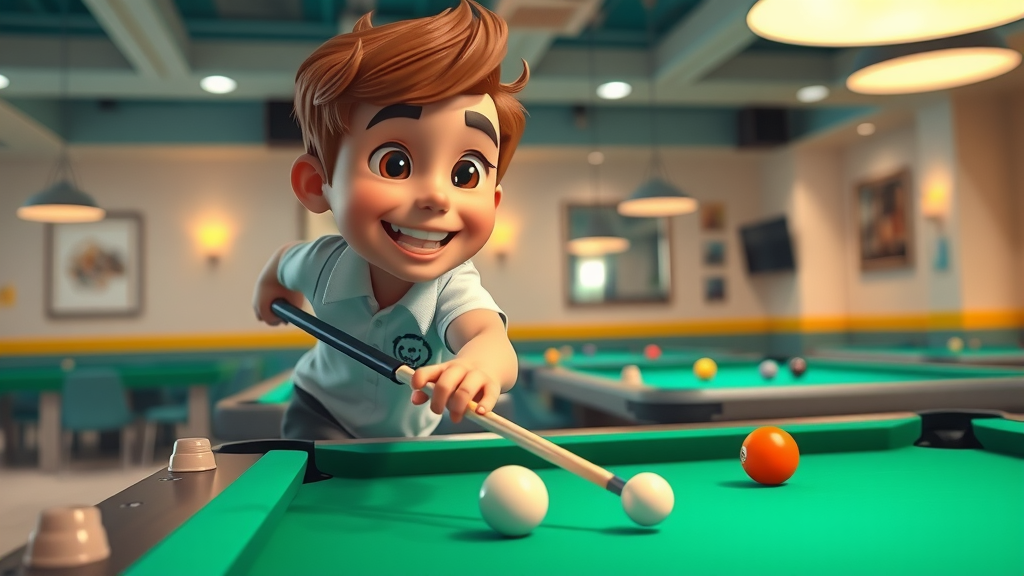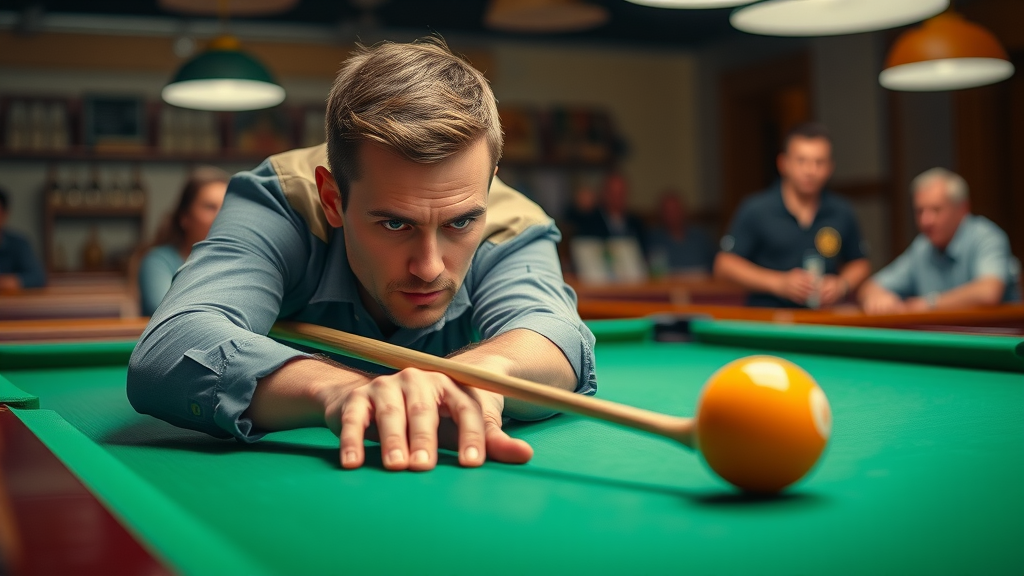Ever wondered why some players seem to win at billiards time after time, no matter who their opponent is? Discover the strategic edge that top competitors use to dominate the pool table —a winning approach built on billiard game planning , patterns and positioning . This guide will unravel the expert techniques and thought processes that separate champions from casual players. Curious how pros consistently control the game—and how you can do the same? Read on to learn the blueprint for repeatable success on the felt.
Can Effective Billiard Game Planning Really Transform Your Win Rate?
-
Explore why mastering billiard game planning is more than just skill—it's strategic thinking
-
Discover how top players use patterns and positioning on any pool table to dominate
-
Challenge common misconceptions about luck versus preparation in billiards
Billiard game planning is far more than shooting accurately—it's the mental foundation for every shot you play. Many beginners assume that consistent success comes from natural talent or good luck, but professionals know that preparation and pattern play are the real game changers. By proactively analyzing the layout of the pool table , visualizing patterns and positioning , and mapping out a strategy several shots ahead, experienced players eliminate random outcomes and set themselves up for success.
In every game, you face complex decisions that determine your next move. Professional players don't just react—they anticipate, adjust, and execute sequences that keep them in good position shot after shot. Challenging the notion that billiards is a game of chance, this article will reveal how an analytical approach, combined with repeatable routines, consistently tips the odds in your favor.

Essential Elements of Billiard Game Planning on the Pool Table
To master billiard game planning , you must understand the core components that drive consistency: patterns and positioning . These elements form the backbone of every successful player’s strategy on both the pool table and snooker table . At the heart of good planning is the ability to visualize the path of the cue ball and object balls several moves in advance—breaking down complex racks into manageable sequences or patterns.
Strategic thinking comes into play as you identify optimal routes to run out the table, optimizing each shot’s position to leave the cue ball in a good spot for what comes next. This is more than technical skill; it’s about foresight, observation, and the discipline to resist tempting shots that offer little future payoff. Whether you’re practicing alone or competing, focusing on patterns and positioning during every rack will drastically improve your control over outcomes.
Understanding Patterns and Positioning in Billiard Game Planning
-
Definition and importance of patterns and positioning
-
How observation and foresight play key roles in billiard game planning
-
The role of visualization in managing the pool table
In pattern play , a "pattern" refers to the sequence of shots that enables you to clear balls in an effective, low-risk order. Proper positioning is about where you leave the cue ball after each shot—always setting up the next, minimizing awkward angles, and avoiding potential snookers. Top players hone their skills by focusing on these two aspects, watching how their shots affect the layout and continuously adapting.
Visualization is critical: before taking each shot, imagine the movement of the white cue ball and object balls, predicting possible outcomes. This observation and pre-planned approach allow players—not luck—to dictate the flow of the game. As you develop your billiard game planning, try to anticipate not just your current shot, but several balls ahead, mirroring how pros approach each turn.
Mastering Basic Patterns for Effective Billiard Game Planning
The journey to mastering billiard game planning begins with understanding and applying basic patterns . These are straightforward, highly reliable shot sequences that help you maintain control and avoid risky situations. Developing proficiency with basic pattern play gives you the tactical knowledge to run tables consistently, whether you're playing eight-ball, nine-ball, or on a full-sized snooker table .
Adopting a "pattern mindset" means you’re not simply aiming for the next ball, but considering the layout as a puzzle—each move setting up the next piece. Utilize drills and structured practice on the pool table to internalize these patterns until they become second nature, serving as a foundation for more advanced strategies down the line.
How to Identify and Utilize Basic Pattern Play
-
Step-by-step breakdown of common basic patterns
-
How to create an effective pattern play strategy for consistent wins
-
Examples of applying basic pattern concepts on the pool table
To develop your pattern play , start by familiarizing yourself with the basic patterns most frequently used by both beginners and advanced players. An effective strategy involves identifying clusters of balls, choosing routes that minimize cue ball movement, and always striving for a good shape on your next shot. For instance, players often clear balls on one side of the table first or link sequences that allow simple angle shots to flow continuously.
Practice by setting up classic patterns—like straight lines or triangles—where the objective is to pot each ball while keeping the cue ball in a good spot for optimal continuation. Each successful run strengthens your ability to visualize and execute when it matters most. Over time, these basic patterns lay the groundwork for recognizing and improvising complex layouts under pressure.

|
|
|
|
Comparison of Basic Patterns vs. Advanced Patterns in Billiard Game Planning |
|
Pattern Type |
Key Features |
Difficulty Level |
Best For |
|---|---|---|---|
|
Basic Patterns |
Straight shots, simple sequences |
Beginner to Intermediate |
Early racks |
|
Advanced Patterns |
Complex sequences, position control |
Advanced |
Closing games |
Developing Advanced Pattern Play for Consistent Billiard Game Planning
Once you’re proficient with basic patterns , elevate your billiard game planning by integrating advanced patterns and cue ball control strategies. Advanced players learn to manage tricky ball clusters, play precise positional shots, and plan for run-outs that seem impossible to most. This level of pattern play takes a lot of practice and requires constant assessment of the table layout, especially in high-pressure scenarios.
Key to this phase is anticipating multiple outcomes, using speed, spin, and angles to maximize your strategic advantage. Watching videos of professional players executing advanced pattern play can provide valuable insights—see how they move the cue ball effortlessly, recover from tough positions, and consistently finish strong under the spotlight.
Strategies Used by Advanced Players to Maximize Pattern Play
-
Reading advanced patterns for run-outs
-
Managing cue ball control and positioning for advanced sequences
-
Avoiding common mistakes in advanced pattern play
Advanced players excel by reading even the most challenging table layouts and developing a "plan for run-outs"—creating a roadmap that involves weaving through complicated positions, often involving strategic use of rails. They vary cue ball placement not just to make the next shot easier, but to avoid traps, clusters, or interfering balls.
Success hinges on maintaining good shape throughout the pattern. This means controlling speed and spin so that after sinking each ball, the white cue ball ends up in a good position for the following attempt. Advanced pattern play also involves contingency planning—knowing when to play a safety rather than forcing a difficult shot. Each choice is informed by acute observation, skill, and an unwavering commitment to the plan.
“Consistent victories in billiards are built not just on talent, but on disciplined planning and strategic pattern play.” – Professional Pool Champion

For a hands-on understanding, watch videos of professional players demonstrating both basic and advanced pattern play on the pool table . Pause and analyze their shot choices, observing how their pre-shot routines, visualization, and position management drive consistent, high-level performance.
These visual guides reveal subtleties such as body alignment, timing, and the importance of leaving the cue ball in a good spot . By integrating these visual lessons into your practice routine, you'll reinforce the principles of strategic billiard game planning , accelerating your growth as a player.
People Also Ask: What is the 30 rule in pool?
Explaining the 30 Rule's Relevance to Billiard Game Planning
-
Origin and application of the 30 rule
-
How it impacts pattern and position decisions
-
Importance for players mastering billiard game planning
The 30 rule in pool is a widely adopted guideline for cue ball movement: after a shot, if you strike the object ball at a 30-degree angle, the cue ball will deflect at 30 degrees from the tangent line. This rule is instrumental in pattern play , as it assists players in reliably sending the cue ball into strong follow-up zones—essential for staying in good position .
When incorporated into your billiard game planning , the 30 rule empowers predictable outcomes, especially during run-outs or when tackling advanced patterns . Professional players often rely on this principle to manage table layouts and execute seamless sequences on the pool table or billiard table , making it a must-know for players seeking mastery.
People Also Ask: What is the 3 wall rule in pool?
How the 3 Wall Rule Affects Pattern Play in Billiard Game Planning
-
Rule explanation and scenarios
-
Strategic implications for patterns and positioning
The 3 wall rule (more commonly, the "three cushion rule") is prominent in certain variations of billiards and pool, demanding the cue ball to contact at least three rails before hitting the final object ball. This rule challenges your pattern play by requiring greater foresight, precision, and cue ball control to satisfy legal shot criteria during each turn.
Recognizing scenarios where the 3 wall rule applies pushes players to choose routes that maintain patterns and positioning suitability, while ensuring rule compliance. The discipline involved in calculating bank angles, cue ball speed, and expected rebounds enhances your anticipation skills—attributes that are essential for advanced levels of billiard game planning .

People Also Ask: How to play billiards game step by step?
A Step-By-Step Guide: Applying Billiard Game Planning from Break to Finish
-
Setting up the pool table
-
Planning the break shot
-
Assessing the table for basic patterns
-
Mapping out your positional play
-
Executing advanced patterns for result
-
Finishing and resetting for the next round
Successful play starts long before your first shot. Begin by setting up the pool table with care, ensuring the rack is tight and balanced for a predictable break. Next, visualize your break shot’s impact—where the cue ball and object balls might scatter—to anticipate your opening pattern. As the balls settle, take a moment to scan for basic pattern opportunities, identifying which clusters to address first for smooth progression.
As you execute your shots, continuously reassess and map out your pattern play , keeping the cue ball on track for subsequent attempts. When faced with more complex tables, incorporate advanced patterns , focusing on maintaining good position and adjusting spin or force as needed. After clearing the table, mentally review your approach and start the cycle again for the next round.
People Also Ask: How do you arrange a pool game?
Arranging a Pool Game for Better Billiard Game Planning
-
Pre-game planning tips
-
Importance of rack integrity for patterns
-
How to mentally prepare for pattern play
Efficient billiard game planning starts before your match begins. Arrange your pool game by selecting an appropriate table (ensure the billiard table is level and the balls are clean), and focus on racking the balls with precision. A well-racked set enables more predictable pattern possibilities after the break, helping you avoid early-game complications.
Mental readiness is as vital as physical technique. Remind yourself of your pattern play objectives and review previous games or videos of professional players for inspiration. Use a pre-game routine—calm breathing, brief visualization, and even warm-up shots—to set the tone for focused, strategic gameplay from the first break.
Proven Practice Routines for Billiard Game Planning Mastery
Daily Drills and Pattern Play Exercises for Any Pool Table
-
Structured drills to strengthen positioning
-
Practice methods for both basic and advanced patterns
-
Tracking your progress over time
Mastery of billiard game planning comes from devoted, structured practice. Begin your session with drills that target cue ball positioning—such as practicing straight shots with varying power or using just the white cue ball and a single object ball to hit designated marks. Next, set up and practice basic patterns , moving on to simulate end-game advanced patterns as your confidence grows.
Keep a log of your progress, noting which patterns you struggle with and any recurring mistakes in pattern play . Challenge yourself by recreating tough situations from videos of professional players . Over time, you'll develop the keen pattern recognition and muscle memory that set advanced players apart on the pool table .

Advanced Patterns: Case Studies from Championship Billiard Game Planning
Real Game Scenarios and Key Takeaways for Advanced Players
-
Analysis of expert matches
-
Lessons learned from critical pattern decisions
-
What separates average from elite in billiard game planning
Analyzing championship matches shines a light on how advanced players approach pattern play under pressure. In one notable final, a pro used a blend of soft touch and precise spin to navigate a tricky cluster, clearing four balls by never letting the cue ball stray from a good spot . The most crucial takeaway? Elite players prioritize maintaining optimal position over taking crowd-pleasing shots, demonstrating the discipline that anchors elite-level billiard game planning .
Each decision in these games reflects years of study, lot of practice , and deep familiarity with patterns and positioning . Review footage of such matches and break down each shot—note how professionals use safety play when no viable pattern emerges, reinforcing that knowing when to play conservatively is as important as offensive prowess.
Common Mistakes to Avoid in Billiard Game Planning
-
Overlooking the importance of basic patterns
-
Misjudging positional play
-
Neglecting continuous reassessment during a game
Common pitfalls among budding players include skipping basic patterns in favor of flashy shots, misjudging where to leave the cue ball , and failing to adapt strategy as the game unfolds. These errors disrupt even the best-laid plans, leading to missed opportunities or forced safety plays.
Combat these issues by continually reassessing the table after every shot and maintaining the discipline to stick to proven patterns and positioning principles. Make continuous learning and adjustment your default mindset, especially after mistakes—a hallmark trait among consistently successful players.

Expert Answers: FAQs on Billiard Game Planning, Patterns and Positioning
-
What is pattern play in billiards?
-
How do advanced players consistently control the game?
-
Can new players learn advanced patterns quickly?
-
Tips for improving pattern play on smaller pool tables
Q: What is pattern play in billiards? A: Pattern play is the strategic sequencing of shots to clear the table efficiently. By planning several shots ahead and controlling the cue ball , players maintain momentum and minimize risk.
Q: How do advanced players consistently control the game? A: Advanced players excel by visualizing entire racks before starting, adjusting for evolving table layouts, and using advanced techniques for cue ball positioning, ensuring they're always in a good spot for their next move.
Q: Can new players learn advanced patterns quickly? A: With dedicated practice and studying videos of professional players , even beginners can progress rapidly from basic patterns to advanced pattern play . Consistency comes through repetition and persistent analysis.
Q: Tips for improving pattern play on smaller pool tables? A: Focus on cue ball speed control and shorter patterns; always adapt your strategy for limited space, and watch professional matches on smaller tables to grasp the nuances of modified pattern play and good position maintenance.
Key Insights for Achieving Consistency in Billiard Game Planning
-
Summarizing effective patterns, positioning, and advanced pattern techniques
-
Reinforcing that consistent wins start with smart billiard game planning
Consistent wins on the pool table begin with disciplined billiard game planning . Master basic and advanced patterns and positioning , and make strategic foresight—rather than luck—your greatest ally.
Ready to Put Your Billiard Game Planning to the Test?
-
Challenge yourself using these strategies in your next game
-
Share your successes and learnings with the community
-
Continue honing pattern play for ongoing improvement
Take control of your next match—implement smart billiard game planning , embrace patterns and positioning , and experience the transformation for yourself. Share your progress and keep sharpening your skills for every game ahead!
 Add Row
Add Row  Add
Add 


Write A Comment